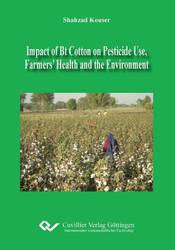| Departments | |
|---|---|
| Book Series (96) |
1378
|
| Nachhaltigkeit |
3
|
| Gesundheitswesen |
1
|
| Humanities |
2367
|
| Natural Sciences |
5406
|
| Mathematics | 229 |
| Informatics | 319 |
| Physics | 980 |
| Chemistry | 1363 |
| Geosciences | 131 |
| Human medicine | 243 |
| Stomatology | 10 |
| Veterinary medicine | 108 |
| Pharmacy | 147 |
| Biology | 835 |
| Biochemistry, molecular biology, gene technology | 121 |
| Biophysics | 25 |
| Domestic and nutritional science | 45 |
| Agricultural science | 1004 |
| Forest science | 201 |
| Horticultural science | 20 |
| Environmental research, ecology and landscape conservation | 148 |
| Engineering |
1793
|
| Common |
98
|
|
Leitlinien Unfallchirurgie
5. Auflage bestellen |
|
Advanced Search
Impact of Bt Cotton on Pesticide Use, Farmers’ Health and the Environment (English shop)
Shahzad Kouser (Author)Preview
Table of Contents, PDF (27 KB)
Extract, PDF (100 KB)
Agriculture remains the most important sector for promoting economic growth in developing
countries. In agriculture-based economies, the sector accounts for about 29% of the gross
domestic product (GDP) and employs 65% of the labor force (World Bank, 2007). About 75% of
the world’s poor live in rural areas, where agriculture is the main economic activity. Crosscountry comparison shows that GDP growth induced by agriculture is at least twice as effective
in reducing poverty as GDP growth outside agriculture (World Bank, 2007). Agriculture is,
therefore, imperative in reducing mass poverty and food insecurity in developing countries.
| ISBN-13 (Hard Copy) | 9783954042821 |
| ISBN-13 (eBook) | 9783736942820 |
| Final Book Format | A5 |
| Language | English |
| Page Number | 182 |
| Lamination of Cover | matt |
| Edition | 1. Aufl. |
| Publication Place | Göttingen |
| Place of Dissertation | Göttingen |
| Publication Date | 2012-11-21 |
| General Categorization | Dissertation |
| Departments |
Agricultural science
|
| Keywords | Wirtschafts- und Sozialwissenschaft des Landbaus Agriculture, economic growth, developing countries, agriculture-based economies, gross domestic product, labor force, poor live, rural areas, economic activity, Crosscountry, poverty, reducing, World Bank, mass poverty, food insecurity |








